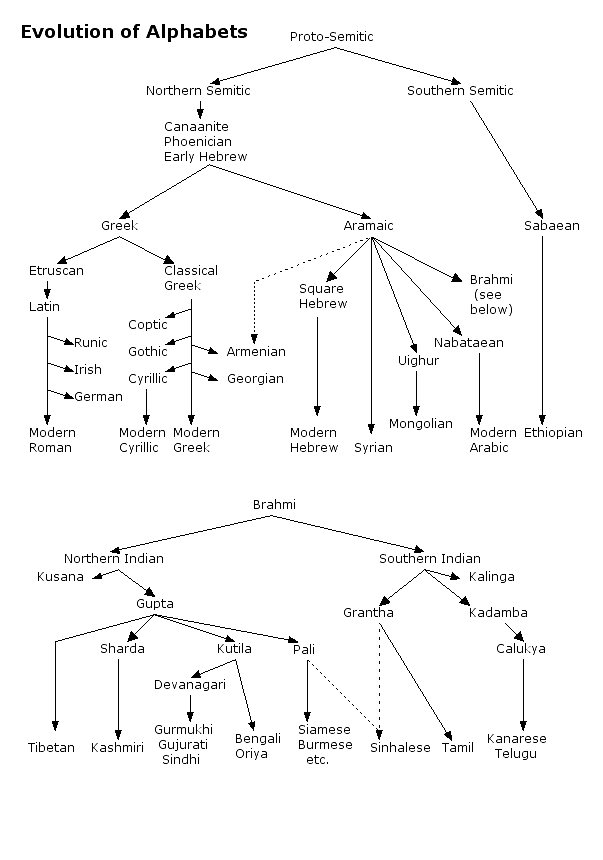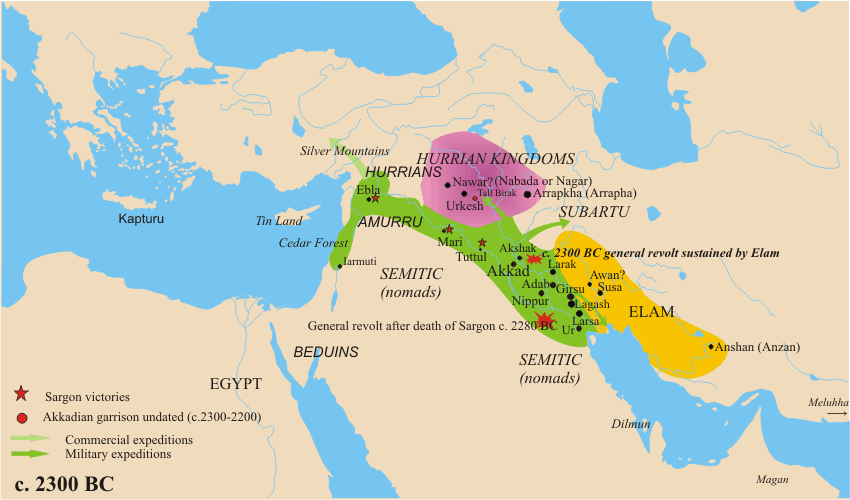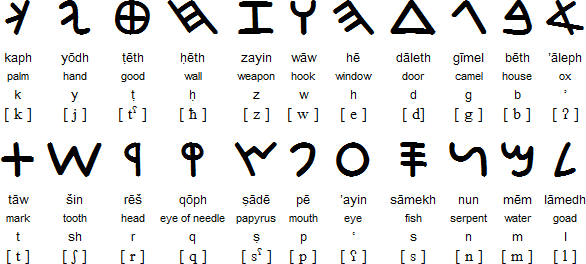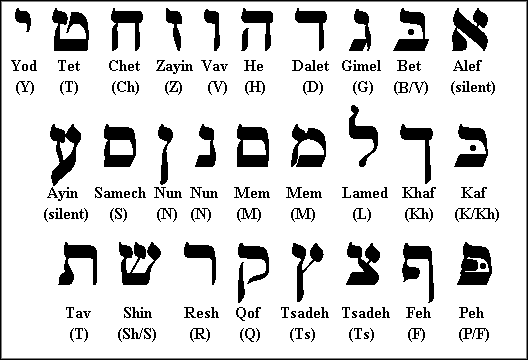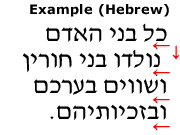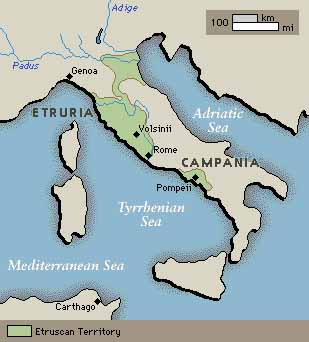
If you refer back to the alphabet tree, the Proto-Semitic script is at the top. The main change from the Proto-Semitic to the Phoenician script was that the latter script became more abstract and the letters less resembled the object upon which the original Proto-Semitic character was based.
(click on this for an image you can actually read - sorry)
An interesting point of comparison between Hebrew, Arabic and English is the use of different symbols for the same "letter" depending upon where the letter appears appears in the word. In English we are used to to using a different shape for the first letter of our alphabet if it occurs as the first letter in the word - i.e. "A" is used as a capital letter and "a" is the lower case letter. Here is our alphabet with the uppercase versions written underneath:
a b c d e f g h i j k l m n o p q r s t u v w x y z
A B C D E F G H I J K L M N O P Q R S T U V W X Y Z
For this font, the letters CKOSUVWXZ seem to have very similar lower case versions. Hebrew uses different versions of four letters (kap, mem, pe and tsade) - the second version being used if the letter occurs "last" in a word. Or is it "first" given that Hebrew is written right to left?
Arabic is very interesting in that it has three versions of a letter depending upon whether the letter occurs at the beginning, the end or the middle of the word. The use of a specific version of a letter for a particular place in a word is called allography and the letters so used are called allographs.
Now, back to languages which didn't have vowels in them - the so called consonontal writing systems.
Referring back to Boeree's alphabet tree, locate the branch occurring at Canaanite/Phoenician/Early Hebrew, and follow that right hand branch through Aramaic to Hebrew (Square and Modern). The Hebrews adapted the Aramaic script into what has become known as Jewish or square script.
Although we have departed from the branch containing Modern Roman, this serves as a good illustration of how the consonantal Aramaic was adapted to an alphabet containing vowels by using diacritics. By 900 BCE, dots and lines were being added to letters to indicate the presence of a vowel. The following implementation of diacritic use was known as the Tiberian system - Tiberias was a city in Palestine.
This example shows how the letter "b" (bet) was "accented" (using the French equivalent term):

The superscripts on the letter "o" (i.e. bo1, and bo2) indicate pronunciation variations between dialects.
Around 600AD
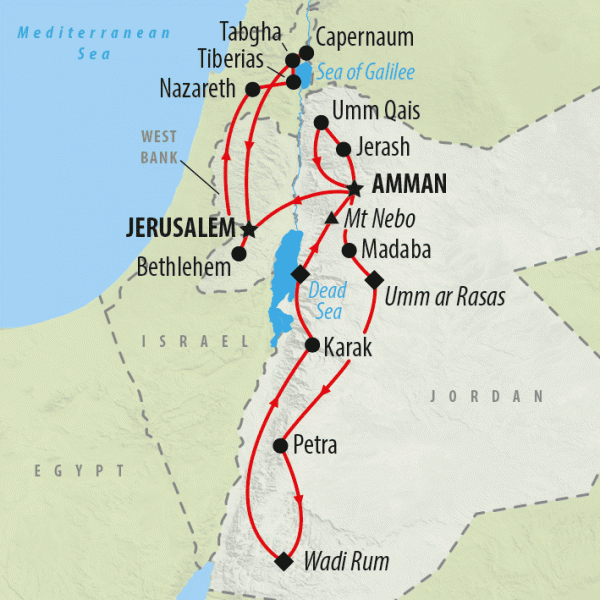
On the map to the left, Tiberias is North East of Nazareth.
But I digress.
The alphabets of India, Buddhist Southeast Asia and Ethiopia also add vowel marks to consonant letters.
Vajda contends that one of the modern day Ethiopian alphabets derives from Phoenecian consonant writing, but this is at variance from Boeree (see his alphabet tree again). The language, Amharic, uses diacritics with consonants the denote vowel sounds and they produce what are called "syllabic letters". I will not go any further into these here but I refer you to Vajda and Omniglot (see References last post) should you want to read further.
It is interesting that Omniglot agrees with Boeree
Well, thanks for following this week. Next week I'll come back to the main branch of Boeree which puts us back on track for the Roman Alphabet.
Thanks for reading this week!
Tez
----------------------------------------------------------
Discussion/Reflection
describe the research process for that week
Following Boeree's alphabet tree, I continued to look at the consonantal nature of the Phoenician language alphabet. This led onto investigating how the vowels were incorporated into their alphabet without adding any new letters, a process which I found intriguing. Their use of diacritics led me to a brief examination of a similar change that was made to Ancient Hebrew - it uses consonantal alphabet also. I then wondered about accents in French and when/why diacritics are used in English words (e.g. learnèd and Brontë).
document your research findings so far
The consonantal alphabets added special markings to existing "letters" so that vowel sounds could be explicitly incorporated in writing. In the case of speakers of Ancient ("Square") Hebrew, this was done for pragmatic reasons. Local languages were adopted for convenience, and spoken Hebrew was relegated to religious ceremonies. With this relegation came loss of familiarity with the spoken language and the previously "understood" placement of vowel sounds. The diacritics were adopted to maintain the integrity of Hebrew pronunciation for subsequent generations.
include a reflection on your research process and any difficulties experienced
I have strayed a little from the predicted research path but have encountered some fascinating facts about how alphabets have evolved and, just as importantly, why? The difficulty this week has been "what to leave out". There is so much amazing material to be read. I have decided to "get back to the Etruscans" but I have enjoyed the journey this week.
share your discoveries, good reference resources, website links, podcasts, image or video resources.
The French use diacritics to change the sound of letters.
For French words which have a diacritic on a letter when written in lowercase (eg the e in sales, meaning salted), the diacritic is sometimes omitted when capitals are used. So biscuits saleés (salted crackers) "may" be written BISCUITS SALES on a sign. One problem with this is that "biscuits sales" means dirty crackers, as does BISCUIT SALES! Some people prefer to maintain the diacritic (also known as an accent) when the letter is capitalised, so it is written BISCUIT SALEÉS instead. The practice of leaving out the accent on capitalised letters was a throw back to the times when diacritics could not be represented on early computer keyboards, so their inclusion became optional.
Some French diacritics, eg that used in étude, derives from the Old French estude. It became a habit to omit the "s" following the "e" and the accent on the "e" in étude is used to signify this. So has English done something similar when we write "haven't" when we mean "have not"? The answer is no, but if you are interested see the Trask1 discussion. In particular you should see his references to learnèd and Brontë.
The Grunert1 discusses diacritics in French.
The story of the Hebrew language is an interesting one and I recommend Omniglot1 for further reading.
---------------------------------------------------------------------
References
Grunert1
Grunert, J 2010, French accent marks, Love To Know Corporation, viewed 8 May 2010, http://french.lovetoknow.com/French_Accent_Marks
Omniglot1
Ager, S 2010,Hebrew,Omniglot: writing systems and languages of the world, viewed 8 May 2010, http://www.omniglot.com/writing/hebrew.htm
Trask1
Trask, L 1997, Diacritics,University of Sussex, viewed 8 May 2010,
http://www.informatics.sussex.ac.uk/department/docs/punctuation/node43.html
